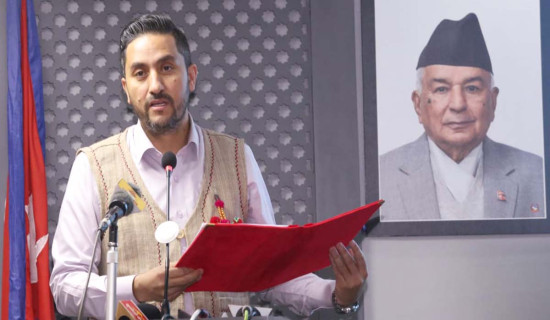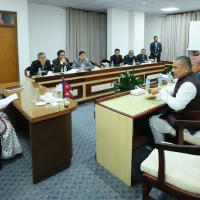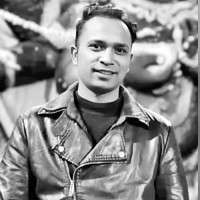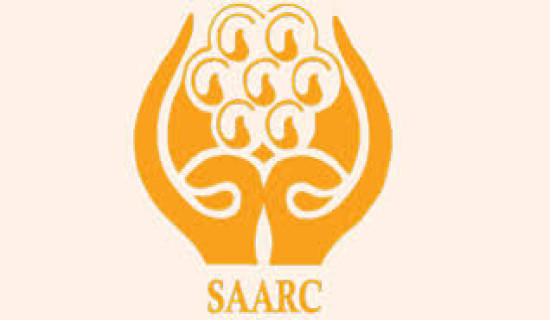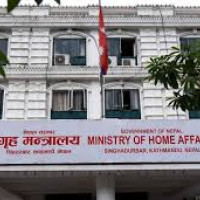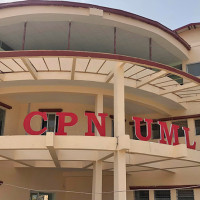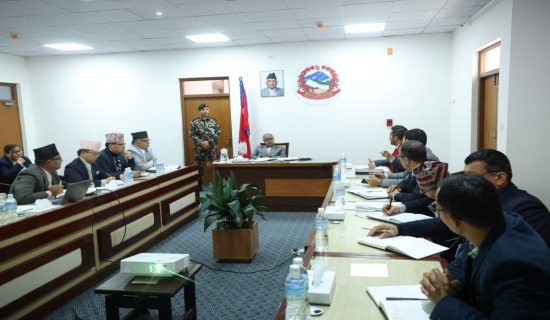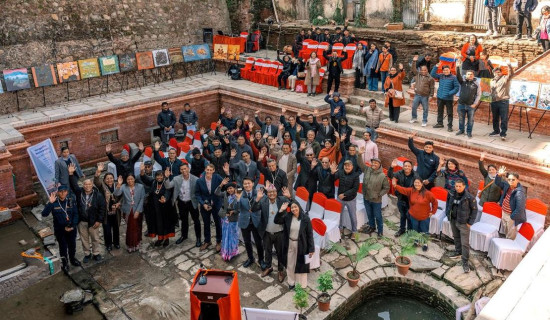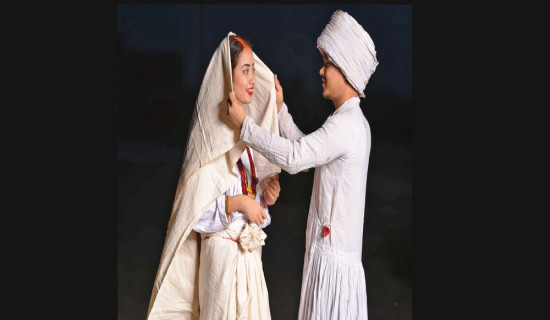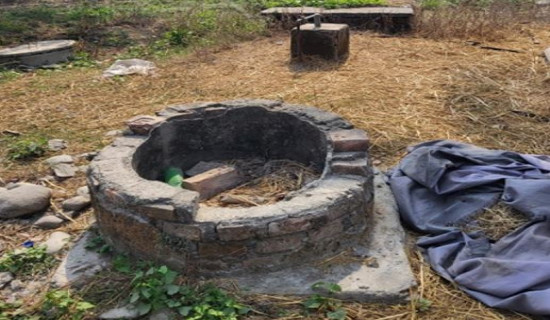- Monday, 8 December 2025
Democracy Day Special
Overview Of Nepal's 1951 Revolution
February 18, 1951, was a major turning point in Nepal’s history for several reasons. That day King Tribhuvan, who had just returned from India, made the historic proclamation saying that there would be first a Rana-Nepali Congress coalition government and that the county would be run later on by the democratically elected governments under the constitution written by the people’s representatives. The proclamation as such effectively ended the 104-year-old Rana family autocracy of hereditary prime ministers.
Although the newly formed cabinet was still led by the last Rana Prime Minister Mohan Shumsher, the family rule that kept the monarchy like in the golden cage inside the palace and the Nepali people under a severely oppressive and exploitative condition was counting its last days. Evidently, the coalition government collapsed in just nine months, and the new government was led by Nepali Congress president Matrika Prasad Koirala in November 1951, contrary to the expectation that it would be led by B. P. Koirala, who was regarded as the true leader playing a key role in the people’s revolt against the Rana autocracy.
Instability
Like in most cases in world history, society in general and national politics in particular during the post-revolutionary days were unstable as different forces jockeyed for their predominance and government leadership. Thus, post-1951 Nepal was unfortunately destined to go through a decade of political instability caused by both internal and external forces. Internally, like in France before 1789 or Russia before 1917, there was a deep discontent in the people against the autocracy of the Rana rulers, who kept the people in educational darkness and abject poverty. The hanging and shooting of four martyrs in 1940 was a stark reminder of this oppressive rule.
They were also keeping Nepal in tight isolation from the rest of the world. For a hundred years until 1947, the country had so-called ‘diplomatic’ contacts with only Britain or India under British colonial rule. In a hundred years from 1846 to 1947, not even a hundred Europeans visited Nepal nor did a hundred Nepalis visit Europe. But as an unavoidable aftermath of the Second World War, the entire South Asia was waking up to an apocalyptic change on the horizon. India was soon to be independent in 1947 after a two-century-long British subjugation, and it would naturally try to exercise its regional hegemony. To the north of Nepal, China was also preparing under the leadership of Mao Zedong for a communist revolution in 1949.
At the global level, an unbridgeable rift between the US and the USSR, which had fought the Second World War from the same side, was emerging as the Cold War, and it was perceived that communist China would be on the side of the USSR in this new pattern of East-West rivalry. Thus, Nepal would be caught between China and India at the regional level and the USA and the USSR at the global level. Independent India under Nehru was up to manage its security concern in Nepal so it got the last Rana Prime Minister to sign the Treaty of Peace and Friendship on the 31st July 1950 as a substitute to the 1923 Nepal-Britain Treaty.
Then, while the Ranas wrongly felt confident about the Indian support for continuing their family rule, Nehru believed that such an undemocratic regime would be starkly anomalous in the post-colonial world that was witnessing the strong wind of freedom and democracy blowing almost everywhere. So, he remained concerned. The Indian ambassador C. P. N. Singh was assigned the job of diplomatically managing the Indian concerns in Nepal. So, ambassador Singh orchestrated in October 1950 the dramatic escape of King Tribhuvan’s entire family to New Delhi where he was given a political asylum almost in captivity.
A tripartite agreement of sorts was forced upon all three sides: the monarchy, the Ranas and the rebelling Nepali Congress. Although the ‘agreement’ as such was not to the liking of any of the Nepalese side, it was so coercively brokered that there was no immediate way out for any forces of Nepal. An election to the Constituent Assembly that King Tribhuvan promised in February 1951 was never held during his rule. When he died in 1955, his son Mahendra ascended the throne and was averse to the idea of general elections let alone the Constituent Assembly polls.
However, after strong popular pressure expressed through a massive civil disobedience movement in Kathmandu and surrounding areas, he promulgated the Constitution of Nepal and reluctantly held the general elections in February-March, 1959 as he was advised by his close confidants that no party would win a simple majority in the parliament.
However, contrary to the King’s expectations, the Nepali Congress won a two-thirds majority (74 seats in the parliament consisting of a total of 109 seats). With such the overwhelming popularity of Nepali Congress government under BP Koirala, it was probably natural that the King felt threatened to lose his traditional authority even as a constitutional monarch although he had kept emergency powers in the constitution that he had ‘granted’ to the people. So, he decided to stage a coup against the elected government just after eighteen months. On December 15, 1960, he arrested and imprisoned the prime minister and his cabinet colleagues and almost all political party leaders. He dissolved the House of Representatives (HoR) and practically ended the short yet vibrant experiment with democracy.
It was an unfortunate incident that sowed the seed of people’s distrust of the monarchy. The long-term consequence of his action was that the institution of monarchy itself was gradually weakened after he died in 1972 and eventually abolished in 2008 as a result of an attempt to assert similar power by his son King Gyanendra, who succeeded to the throne after a dreadful royal palace massacre in which his brother King Birendra’s family was all killed.
King Mahendra’s drastic step against the elected government including the political system of parliamentary democracy in the country had both domestic and international aspects to it. Domestically, the King felt that the people of Nepal with so much poverty and illiteracy were not ready for a truly democratic polity. Internationally, the heightening of Cold War gave support to the King’s action favouring stability in the strategically located Nepal. India, in the context of its worsening relations with communist China, felt that the King’s direct rule would be a bulwark against communism.
China, on the other hand, felt that the King would be a better force in Nepal against the Indian hegemony and interference, so the Chinese supported the King vis-a-vis the political parties especially the Nepali Congress which was perceived by it to be pro-India. Even the US, although distant but a global superpower, perceived that the King would be a better option against China as it saw extreme poverty in Nepal as a fertile ground for communism. But all those external powers were wrong as the King’s step would lead to perpetual instability in the country in which all political forces were active with contractor goals.
Floodgates
The end of the Rana rule in 1951 had opened the floodgates of Nepal’s politics, economy and foreign relations. A country that was considered, and was actually a forbidden kingdom for centuries, was suddenly open. The shaky shacks of the people living in abject poverty and the European-style palaces of the Rana family members in contrast were an appalling fact for any observers from within and outside the country. Very few people were educated in the country. So, the few educated ones who led the political change of 1951 were making sincere efforts to improve the conditions of their people in education and economic fields.
The National Planning Commission and the National Educational Planning Commission as a complementary body were established. Periodic Plans were introduced. The government also established educational institutions including schools, colleges and a national university at a fast speed.
A land reform programme was launched. Industries were opened with foreign financial aid and expertise that was sought and prudently utilised. There was a clear sense of direction and enthusiasm in the campaign of national reconstruction. However, King Mahendra’s action, despite his sincerity and nationalism defined by some and disputed by others, was an unfortunate setback to the democracy and development of Nepal.
This country would have been blessed with political stability and economic prosperity if it had reconciled with the system of constitutional monarchy as in Britain, Japan and Scandinavian countries. Today, Nepal is a republic but it finds itself faced with the challenges of chronic political instability and chaotic social and economic conditions. Internal and external migration of Nepalis is a challenge and the huge exodus of the youths from the country indicates their loss of faith in their own country. One can only hope that the leaders today learn the lessons from the past and steer the country toward the course of stable political and sustainable economic development.
(Acharya is a former permanent representative of Nepal to the United Nations.)



